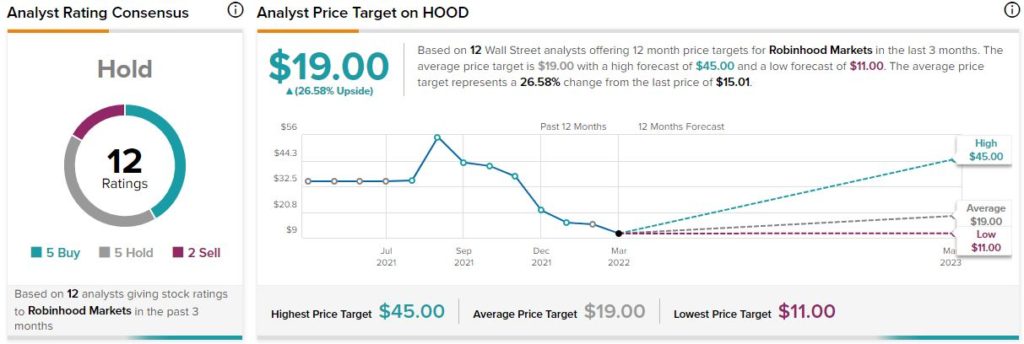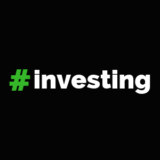Robinhood (HOOD) had experienced one of the worst global high-profile stock market debuts since the inception of the pandemic. The company’s shares have been tanking continuously, making them one of the worst market performers amongst companies that had raised $2 billion or more on global exchanges since early 2020.
Despite its immense popularity, Robinhood’s stock has declined substantially from its IPO price. It is currently down by ~15% year-to-date.
Multiple issues such as rising inflation levels, the conflict between Russia and Ukraine, and most importantly, the regulatory concerns surrounding its payment for order flow revenue model have heightened the pace of its declining growth rate.
The post-COVID-19 decline in cryptocurrency growth hasn’t helped Robinhood either. Robinhood stock is extremely cheap now, and it looks like quite a lucrative investment option. However, the risk involved is still causing investors to shy away from investing in it.
Robinhood Markets is a brokerage that aids in commission-free trading of stocks, exchange-traded funds, and cryptocurrencies. It also has various learning and education solutions like Robinhood Snacks, Robinhood Learn, Robinhood Newsfeed, and so on.
HOOD is a FINRA-regulated broker-dealer which is not only registered with the U.S. Securities and Exchange Commission but is also a member of the Securities Investor Protection Corporation. As of 2021, it boasts about 17.3 million monthly active users and 1.6 million people waiting for its cryptocurrency wallet.
Despite its huge popularity, Robinhood stock hasn’t matched up with investor expectations. From a 52-week high of $85, the stock is now only trading at just over $15.
A range of crucial and problematic factors have more or less tied down the growth of this company. However, Robinhood has a very large customer base and is very popular with the younger crowd. These factors have kept the market hopeful about Robinhood.
The company can use this base to cross-sell other services like crypto wallets or fully paid securities lending to the existing customer base, increasing its revenue generation.
Steven Chubak, a Wall Street Analyst from Wolfe Research, has also more or less expressed an optimistic opinion on the Robinhood Stock and has maintained a Hold rating on its shares earlier this year. However, due to the underlying risks, he had reduced the price target of the company from $33 to $20 while issuing a Peerperform rating to its shares.
Controversies and Regulatory Concerns
Robinhood rose to fame during the pandemic. The company’s user-friendly, no commission, and game-like investment application became a rage among the young and first-time investors community. Social network Reddit also had a share in raising its popularity. Reddit communities drove up the price of meme stocks like GameStop (GME), AMC Entertainment (AMC), and Bed Bath & Beyond (BBBY), further boosting Robinhood’s popularity.
Despite that, the Robinhood stock continued to suffer. The controversies started when Robinhood restricted trading of certain meme stocks under an obscure financial obligation. It was required to put up billions of extra dollars to protect the extra risky trades.
Many market participants accused the company of protecting hedge funds’ interests at the cost of public money. Though the accusation turned out to be false, it did hamper the company’s reputation. Again, the company’s order-flow-based revenue model, through which Robinhood was generating revenue by selling its customers’ order details, further increased people’s resentment toward the company.
Regulatory issues, like paying a fine of $57 million to the Financial Industry Regulation Authority, didn’t help. It also came under fire because of severe regulatory lapses like distribution of false or misleading information to its users, poor regulation of its own technology, improper due diligence while approving options accounts of inexperienced traders, or simply offering incomplete market data to its users. All of these incidents have damaged its reputation among the masses.
Generating Huge Losses
Robinhood’s immense popularity doesn’t get reflected in its financials either. The company has been generating tons of losses over the past year despite the improvement in its revenues. In Q4 2021, the company improved its revenues by a whopping 89% to $1.82 billion for the entire year. Revenue for the quarter grew 14% to $363 million.
However, it still generated a net loss of $3.69 billion for the year and $423 for the fourth quarter compared to the slim profits of $7 million and $13 million it generated in the prior-year periods. In Q4 2021, its net cumulative funded accounts only increased by 1% quarter-over-quarter, and its monthly active users decreased 8% quarter-over-quarter.
Wall Street’s Take
Turning to Wall Street, Robinhood has a Hold consensus rating based on five Buys, five Holds, and two Sell ratings assigned in the past three months. The highest price target for the stock is $45, and the lowest target is $11. The average Robinhood price target is $19, which implies 26.6% upside potential on the stock.

Conclusion
Robinhood’s business model does have prospects, but the company still needs to work a lot to translate its popularity into actual success. Moreover, though the chances of its order flow-based revenue model getting an outright ban from the SEC is still bleak, the stock still involves certain levels of uncertainty.
Therefore, if someone is not that risk-conscious, they can consider the Robinhood stock, as it is exceptionally cheap now and can someday even turn out to be a goldmine if it takes proper corrective steps now.
Download the TipRanks mobile app now
To find good ideas for stocks trading at attractive valuations, visit TipRanks’ Best Stocks to Buy, a newly launched tool that unites all of TipRanks’ equity insights.
Read full Disclaimer & Disclosure
















